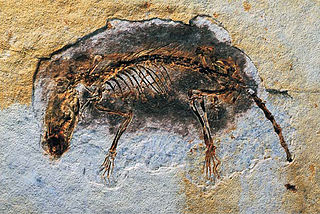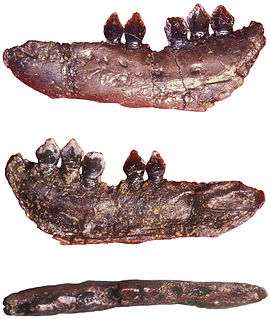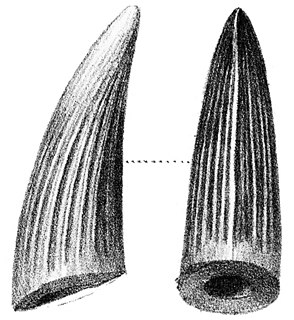
Eomaia is a genus of extinct fossil mammals containing the single species Eomaia scansoria, discovered in rocks that were found in the Yixian Formation, Liaoning Province, China, and dated to the Barremian Age of the Lower Cretaceous about 125 million years ago. The single fossil specimen of this species is 10 centimetres (3.9 in) in length and virtually complete. An estimate of the body weight is between 20–25 grams (0.71–0.88 oz). It is exceptionally well-preserved for a 125-million-year-old specimen. Although the fossil's skull is squashed flat, its teeth, tiny foot bones, cartilages and even its fur are visible.
Plagiaulacida is a group of extinct multituberculate mammals. Multituberculates were among the most common mammals of the Mesozoic, "the age of the dinosaurs". Plagiaulacids, an informal suborder, are the most basal of this order, and ranged from the Middle Jurassic Period to the Lower Cretaceous Period of the northern hemisphere.
Bolodon is a genus of extinct mammal from the Lower Cretaceous of Europe and North America. It was a member of the extinct order of Multituberculata and belongs to the suborder Plagiaulacida and family Plagiaulacidae.

Echinodon is a genus of heterodontosaurid dinosaur that lived during the earliest Cretaceous of southern England and possibly western France in the Berriasian epoch. The first specimens were jaw bones named Echinodon becklesii by Sir Richard Owen in 1861, and since their original description only additional teeth have been discovered. The specific name honours collector Samuel Beckles who discovered the material of Echinodon and many other taxa from across England, while the genus name translates as "prickly tooth" in reference to the dental anatomy of the taxon.

Paranthodon is a genus of stegosaurian dinosaur that lived in what is now South Africa during the Early Cretaceous, between 139 and 131 million years ago. Discovered in 1845, it was one of the first stegosaurians found. Its only remains, a partial skull, isolated teeth, and fragments of vertebrae, were found in the Kirkwood Formation. British paleontologist Richard Owen initially identified the fragments as those of the pareiasaur Anthodon. After remaining untouched for years in the British Museum of Natural History, the partial skull was identified by South African paleontologist Robert Broom as belonging to a different genus; he named the specimen Palaeoscincus africanus. Several years later, Hungarian paleontologist Franz Nopcsa, unaware of Broom's new name, similarly concluded that it represented a new taxon, and named it Paranthodon owenii. Since Nopcsa's species name was assigned after Broom's, and Broom did not assign a new genus, both names are now synonyms of the current binomial, Paranthodon africanus. The genus name combines the Ancient Greek para (near) with the genus name Anthodon, to represent the initial referral of the remains.

Suchosaurus is a spinosaurid dinosaur from Cretaceous England and Portugal, originally believed to be a genus of crocodile. The type material, consisting of teeth, was used by British palaeontologist Richard Owen to name the species S. cultridens in 1841. Later in 1897, French palaeontologist Henri-Émile Sauvage named a second species, S. girardi, based on two fragments from the mandible and one tooth discovered in Portugal. Suchosaurus is possibly a senior synonym of the contemporary spinosaurid Baryonyx, but is usually considered a dubious name due to the paucity of its remains. In the Wadhurst Clay Formation of what is now southern England, Suchosaurus lived alongside other dinosaurs, as well as plesiosaurs, mammals, and crocodyliforms.
Cimolestes is a genus of early eutherians with a full complement of teeth adapted for eating insects and other small animals. Paleontologists have disagreed on its relationship to other mammals, in part because quite different animals were assigned to the genus, making Cimolestes a grade taxon of animals with similar features rather than a genus of closely related ones. Fossils have been found in North America, South America, Europe and Africa. Cimolestes first appeared during the Late Cretaceous of North America. According to some paleontologists, Cimolestes died out at the start of the Paleocene, while others report the genus from the early Eocene.
Haramiyidans were a long lived lineage of mammaliaform cynodonts or mammals. Their teeth, which are by far the most common remains, resemble those of the multituberculates. However, based on Haramiyavia, the jaw is less derived; and at the level of evolution of earlier basal mammals like Morganucodon and Kuehneotherium, with a groove for ear ossicles on the dentary. If they are early multituberculates, they would be the longest lived mammalian clade of all time. However, a more recent study, in November 2015, may dispute this and suggested the Haramiyida were not crown mammals, but were part of an earlier offshoot of mammaliaformes instead.
Amblotherium is an extinct genus of Late Jurassic and Early Cretaceous mammal. The type species Amblotherium pusillum is from the Lulworth Formation of southern England, while the referred species Amblotherium gracile is from stratigraphic zones 2, 3 and 5 of the Morrison Formation of the US.

Dryolestes is an extinct genus of Late Jurassic mammal from the Morrison Formation and the Alcobaça Formation of Portugal. The type species Dryolestes priscus is present in stratigraphic zones 2, 5, and 6.

Pteranodontoidea is an extinct clade of ornithocheiroid pterosaurs from the Early to Late Cretaceous of Asia, Africa, Europe, North America and South America. It was named by Alexander Wilhelm Armin Kellner in 1996. In 2003, Kellner defined the clade as a node-based taxon consisting of the last common ancestor of Anhanguera, Pteranodon and all its descendants. The clade Ornithocheiroidea is sometimes considered to be the senior synonym of Pteranodontoidea, however it depends on its definition. Brian Andres in his analyses, converts Ornithocheiroidea using the definition of Kellner (2003) to avoid this synonymy.

The Ilek Formation is a Lower Cretaceous geologic formation in Western Siberia. Many different fossils have been recovered from the formation. It overlies the Late Jurassic Tyazhin Formation and underlies the Albian Kiya Formation.
Jugulator is a genus of extinct mammal from the Cretaceous of North America. A eutriconodont, it is known from the Cedar Mountain Formation, and is both a large sized and possibly ecologically specialised taxon, showcasing the diversity of mammals in the Mesozoic.

Triconodon is a genus of extinct mammal from the Early Cretaceous of England and France with two known species: T. mordax and T. averianovi. First described in 1859 by Richard Owen, it is the type genus for the order Triconodonta, a group of mammals characterised by their three-cusped (triconodont) molar teeth. Since then, this "simplistic" type of dentition has been understood to be either ancestral for mammals or else to have evolved multiple times, rendering "triconodonts" a paraphyletic or polyphyletic assemblage respectively, but several lineages of "triconodont" mammals do form a natural, monophyletic group, known as Eutriconodonta, of which Triconodon is indeed part of.
Leonardus is an extinct mammal genus from the Late Cretaceous of South America. It is a meridiolestidan dryolestoid, closely related to the also Late Cretaceous Cronopio and the Miocene Necrolestes.
Austrotriconodon is a mammal genus from the Campanian and Maastrichtian of South America. It currently contains only the type species, A. mckennai. Originally assumed to be a eutriconodont, more recent studies have recovered it as a meridiolestidan dryolestoid.

Phascolestes is a genus of extinct mammal from the Berriasian epoch of Early Cretaceous Southern England. The type and only species is Phascolestes mustelulus, which was named by Richard Owen in 1871 for dental material from the Lulworth Formation. Phascolestes is a close relative of co-existing taxon Achyrodon within the subfamily Kurtodontinae of the family Dryolestidae, with Kurtodon being a junior synonym of Phascolestes although the subfamily name is still applicable.
Spalacotherium is a genus of extinct mammal from the Early Cretaceous of Europe. The type species Spalacotherium tricuspidens was originally named by Richard Owen in 1854, and its material includes maxillary and dentary fragments and many teeth from the Berriasian Lulworth Formation of southern England. Referred species include S. taylori, S. evansae and S. hookeri also from the Lulworth deposits, and S. henkeli from Barremian deposits of Galve, Spain. The Lulworth taxon Peralestes longirostris, named by Owen in 1871, is a junior synonym of the type species S. tricuspidens. Spalacotherium is the namesake taxon of the family Spalacotheriidae, which is an extinct clade within Trechnotheria that may be closely related to the Gondwanan clade Meridiolestida, or united with the family Zhangheotheriidae to form Symmetrodonta.S. evansae is also from the Berriasian aged Angeac-Charente bonebed in western France.
Kouriogenys is a genus of extinct mammal from the Early Cretaceous of southern England. The type and only species was originally described as Spalacotherium minus by Richard Owen in 1871 for a dentary with teeth from the Berriasian Lulworth Formation, although it was given its own genus in 2012 by Brian Davis. The genus name is taken from the Ancient Greek "youthful" and "jaw" in reference to the replacement method of the premolars. Kouriogenys is closely related to coexisting genera Peramus and Peramuroides, and along with other genera these make up the family Peramuridae, a group of extinct zatherians.

Aerodraco is a genus of anhanguerid pterosaur from the Albian–Cenomanian-age Cambridge Greensand of England. It contains only one species, Aerodraco sedgwickii. It was originally assigned to the genus Pterodactylus.















